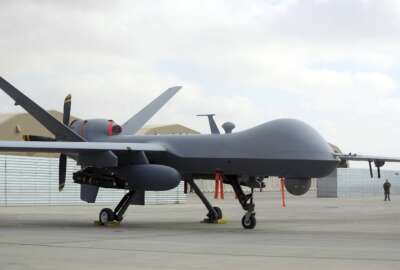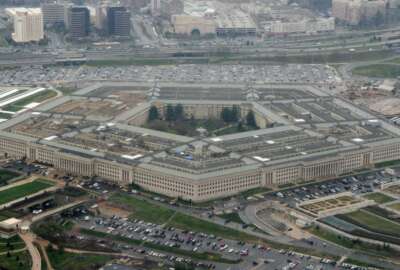DoD adds new drones, software enablers under Replicator
The announcement of new capabilities is for the second tranche of Replicator. Replicator 2 effort announced in September will focus on countering small drones.
The Pentagon is adding new drones and integrated software enablers to its second tranche of the Replicator program, which is focused on the rapid production of cheap autonomous drones, the department announced Wednesday.
Since the launch of the program last August, defense officials have been tight-lipped about the initiative, and prior to this week’s announcement, the only publicly disclosed drone used in the program was AeroVironment’s Switchblade 600.
Deputy Defense Secretary Kathleen Hicks said the Anduril Industries Ghost-X and Performance Drone Works C-100 UAS selected for the second tranche of Replicator will advance the Army’s Company-Level Small Unmanned Aerial Systems (UAS) effort.
In September, Doug Bush, the Army’s assistant secretary for acquisition, logistics, and technology, said the service is leading the Replicator effort.
“Frankly, in terms of who’s going to deliver first — it’s us. We’re moving out. We’ve already got the contract in place. Production is underway. That was a program we were going to do anyway, but when the interest was expressed by the Replicator effort and [Defense Innovation Unit],” said Bush.
Additionally, the Marine Corps is expanding its Organic Precision Fires program by fielding the Anduril Industries Altius-600, which is now part of the second tranche of Replicator. This system will “complement” AeroVironment’s Switchblade 600.
And finally, the Air Force’s Enterprise Test Vehicle program was chosen to be part of the Replicator initiative. The Air Force and DIU have partnered with four commercial companies to develop prototypes for the program.
The second tranche of Replicator also includes classified systems, such as low-cost long-range strike capabilities and maritime uncrewed systems — those were not named in the announcement.
The Pentagon allocated $500 million for Replicator in 2024 and requested the same amount for fiscal 2025 — Senate appropriators recommended that Congress fully fund the program in their version of the 2025 defense spending bill.
Meanwhile, Defense Secretary Lloyd Austin already announced the Replicator 2 effort, which will address countering small drones at military installations across the globe.
“The Department has been clear about applying Replicator’s focus to other capability areas, and the Department has been working for several months to assess validated joint capability gaps to determine where the Replicator process can provide the greatest value against our most urgent needs,” Austin said in a Sept. 27 memo.
“I have determined that Replicator 2 will tackle the warfighter priority of countering the threat posed by small uncrewed aerial systems (C-sUAS) to our most critical installations and force concentrations. I am confident the Replicator Initiative will complement and advance the significant C-sUAS work already underway in the DoD.”
Defense officials are targeting August 2025 to deploy thousands of drones — Austin said the department is still on track to meet that fielding goal. As for Replicator 2, the goal is to deliver protection against small, uncrewed systems by 2026.
The Pentagon considered over 500 commercial companies for contracting opportunities related to hardware and software development under the Replicator initiative, awarding contracts to 30 companies.
While Replicator focuses on quickly delivering autonomous systems in the hands of warfighters, its larger objective is to change how the DoD acquires and integrates new technologies.
Copyright © 2024 Federal News Network. All rights reserved. This website is not intended for users located within the European Economic Area.







